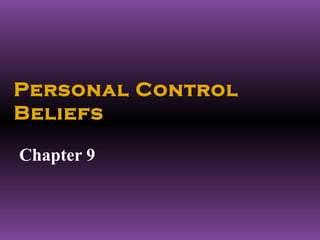
Ch09
- 3. MOTIVATION TO EXERCISE PERSONAL CONTROL Expectancy A subjective predication of how likely it is that an event will occur Efficacy Expectations Motivation to Exercise Personal Control Outcome Expectations
- 4. Two Kinds of Expectancy Outcome Efficacy Expectation Expectation “Can I do it?” “Will it work?” Expectation of being able Expectation that one’s to enact the behaviors one behavior will produce needs in order to cope positive outcomes (or effectively with the prevent negative situation at hand. outcomes). Figure 9.1 Two Kinds of Expectation: Efficacy and Outcome
- 5. Perceived Control: Self, Action, and Control Efficacy Outcome Expectations Expectations Perceived Control Figure 9.2 Self Action Control Model of Perceived Control
- 7. Sources & Effects of Self-Efficacy Personal Behavior Choice History (Approach vs. Avoid) Vicarious Experience Extent of Effort and (Modeling) Self- Persistence Efficacy Verbal Persuasion Thinking and (Pep Talk) Decision Making Physiological Emotional Activity Reactions (Stress, Anxiety) Figure 9.3 Sources and Effects of Self-Efficacy Beliefs
- 8. Empowerment Empowerment involves possessing the knowledge, skills, and beliefs that allow people to exert control over their lives.
- 9. Empowering People: Mastery Modeling Program How to Implement a Mastery Modeling Progr am 1. Expert identifies component skills involved in effective coping and measures novices’ efficacy expectation on each component skills. 2. Expert models each component skill, emphasizing the novices’ most worrisome skill areas. 3. Novices emulate each modeled skill. Expert provides corrective feedback, as needed. 4. Novices integrate the separate component skills into an overall simulated performance. Expert introduces only mild obstacles and helps novices integrate the different skill components into a coherent overall performance. 5. Novices participate in cooperative learning groups. One person gives a simulated performance while peers watch. As they watch, peers provide encouragement and tips. Each person takes a turn until everyone has performed multiple times. 6. Novices perform individually in a near-naturalistic situation that features numerous and realistic difficulties, obstacles, and setbacks while the expert provides modeling and corrective feedback. 7. Expert models confident demeanor and arousal-regulating techniques.
- 10. MAS TERY BELIEFS
- 11. Ways of Coping Way of Coping Illustr ation Taking action by moving toward and interacting with the Approach vs. Avoidance problem vs. walking away from the problem Social vs. Solitary Taking action with a team of others vs. acting alone Proactive vs. Reactive Taking action to prevent a problem before vs. after it occurs Taking action oneself versus enlisting the help of an Direct vs. Indirect intermediary who takes the direct action Control vs. Escape Take-charge approach versus staying clear of the situation Alloplastic vs. Taking action to change the problem versus taking action Autoplastic to change oneself Problem Focused vs. Taking action to manage the problem causing the stress Emotion Focused versus regulating one’s emotional response to the problem
- 13. LEARNED HELPLESSNESS The psychological state that results when an individual expects that life’s outcomes are uncontrollable. Outcomes that Happen to My Behavior Me Other (Uncontrollable) Influences
- 14. Learned Helplessness Seligman and Maier Experiment on Learned Helplessness
- 15. Learned Helplessness Results of a Prototypical Learned Helplessness Study Experimental Phase 1 Phase 2 Results Condition Received shock, no Inescapable Received an Failed to escape from coping response could Shock escapable shock the shock terminate the shock Received shock, Quickly learned to Escapable pressing nose against Received an escape shock by Shock button could terminate escapable shock jumping over barrier shock Quickly learned to Control, No Received an Received no shock escape shock by Shock escapable shock jumping over barrier
- 16. Application to Humans Learned Helplessness Study with Humans Authentic Feedback (Controllable Problem) vs. Random and Bogus Feedback (Uncontrollable Problem)
- 17. Components Objective relationship Subjective personal Listless, demoralized between a person’s control beliefs coping behavior behavior and the environment’s • Biases outcomes • Attributions • Expectancies
- 18. Effects of Helplessness Decreased Acquired pessimistic Energy-depleting willingness to try set that interferes emotions “Why try?“ with one’s ability to (e.g., Listlessness, learn new response- apathy, depression) outcome contingencies
- 19. Helplessness and Depression Perceived Control Judgments for Depressed and Nondepressed Individuals
- 21. Criticisms & Alternative Explanations
- 22. REACTANCE THEORY
- 23. Reactance and Helplessness Integrative Model of Reactance and Learned helplessness
- 24. Putting It All Together: Hope Self-Efficacy Mastery Motivation
